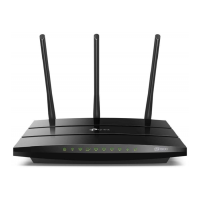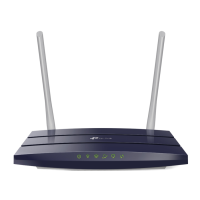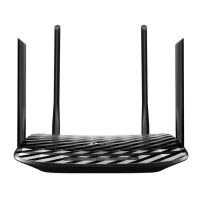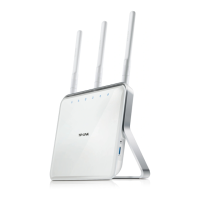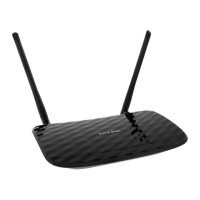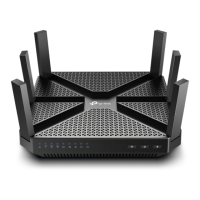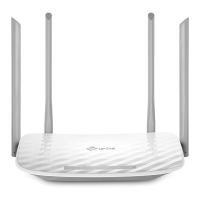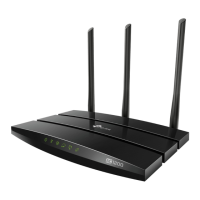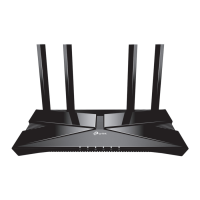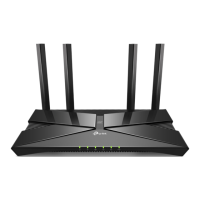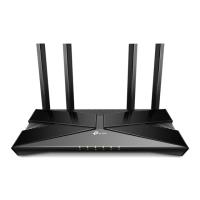Do you have a question about the TP-Link Archer A64 and is the answer not in the manual?
Details how the SPI Firewall protects the router from cyber threats and validates traffic.
Allows blocking or allowing specific devices using MAC addresses via Whitelist or Blacklist.
Prevents ARP spoofing by binding device IP and MAC addresses to the router.
Configures Application Layer Gateway settings, recommended to keep as default.
Enables access to local services like web servers or FTP by forwarding specific ports.
Dynamically opens external ports for specific applications or games upon connection.
Utilizes Universal Plug and Play (UPnP) for simplified online gaming connectivity.
Exposes a device to the internet for unrestricted communication, useful for gaming.
Modifies the router's LAN IP address and subnet mask for network configuration.
Sets up the router for IPTV or VoIP services, potentially requiring VLAN configuration.
Configures DHCP server options, including IP address pools and reservations.
Uses Dynamic DNS (DDNS) to enable remote access to the router via a domain name.
Manually configures routes for data packet forwarding between different networks.
Customizes wireless network name (SSID), password, and security settings.
Sets automatic schedules for turning the wireless network on or off.
Provides simplified Wi-Fi connection setup using Wi-Fi Protected Setup (WPS).
Configures advanced wireless parameters like WMM, AP Isolation, and beacon intervals.
Instructions for updating the router's firmware for improved performance and security.
Guides on saving and restoring router settings to prevent data loss.
Procedures for modifying the router's web management login password.
Limits LAN access to the router's management interface based on MAC addresses.
Allows or forbids remote access to manage the router over the internet.
Saves and views system logs for troubleshooting network issues.
Uses diagnostic tools like Ping and Tracert to troubleshoot network connectivity.
Sets the router's system time and allows changing the interface language.
Schedules automatic router reboots to maintain optimal performance.
Manages the router's LED indicators, including enabling Night Mode.
Details the router's purpose, features, and benefits for SOHO networks.
Describes the physical layout and key components of the router's panels.
Guidelines for optimal router placement to ensure performance and safety.
Step-by-step instructions for physically connecting the modem and router.
Guides users through automated internet connection setup using the router's wizard.
Instructions for setting up the router using the mobile TP-Link Tether app.
Detailed steps for configuring internet connection types like Dynamic IP, Static IP, PPPoE.
Explains how to configure the router to extend an existing wired network wirelessly.
Steps for configuring the router to support IPv6 internet services from an ISP.
Guide to creating a TP-Link ID for cloud-based management and services.
Procedures for updating the email address and password associated with a TP-Link ID.
Instructions on adding or removing other TP-Link IDs to manage the router.
How to use the mobile app for remote router management and monitoring.
Steps to set up a separate Wi-Fi network for guests, isolating them from the main network.
Options to control guest access, such as allowing them to see each other or the local network.
How to block inappropriate content and set time limits for specific devices.
Steps to retrieve or reset the wireless network password if forgotten.
Procedures for resetting the router's web management login password.
Troubleshooting steps for issues preventing access to the router's interface.
Solutions for internet connectivity problems after initial setup.
Steps to resolve issues with detecting or connecting to the Wi-Fi network.
Information on operating and storage conditions for the device.
Clarification of symbols found on the product's packaging or label.
Guidance on proper disposal and recycling of the electronic equipment (WEEE).
Details how the SPI Firewall protects the router from cyber threats and validates traffic.
Allows blocking or allowing specific devices using MAC addresses via Whitelist or Blacklist.
Prevents ARP spoofing by binding device IP and MAC addresses to the router.
Configures Application Layer Gateway settings, recommended to keep as default.
Enables access to local services like web servers or FTP by forwarding specific ports.
Dynamically opens external ports for specific applications or games upon connection.
Utilizes Universal Plug and Play (UPnP) for simplified online gaming connectivity.
Exposes a device to the internet for unrestricted communication, useful for gaming.
Modifies the router's LAN IP address and subnet mask for network configuration.
Sets up the router for IPTV or VoIP services, potentially requiring VLAN configuration.
Configures DHCP server options, including IP address pools and reservations.
Uses Dynamic DNS (DDNS) to enable remote access to the router via a domain name.
Manually configures routes for data packet forwarding between different networks.
Customizes wireless network name (SSID), password, and security settings.
Sets automatic schedules for turning the wireless network on or off.
Provides simplified Wi-Fi connection setup using Wi-Fi Protected Setup (WPS).
Configures advanced wireless parameters like WMM, AP Isolation, and beacon intervals.
Instructions for updating the router's firmware for improved performance and security.
Guides on saving and restoring router settings to prevent data loss.
Procedures for modifying the router's web management login password.
Limits LAN access to the router's management interface based on MAC addresses.
Allows or forbids remote access to manage the router over the internet.
Saves and views system logs for troubleshooting network issues.
Uses diagnostic tools like Ping and Tracert to troubleshoot network connectivity.
Sets the router's system time and allows changing the interface language.
Schedules automatic router reboots to maintain optimal performance.
Manages the router's LED indicators, including enabling Night Mode.
Details the router's purpose, features, and benefits for SOHO networks.
Describes the physical layout and key components of the router's panels.
Guidelines for optimal router placement to ensure performance and safety.
Step-by-step instructions for physically connecting the modem and router.
Guides users through automated internet connection setup using the router's wizard.
Instructions for setting up the router using the mobile TP-Link Tether app.
Detailed steps for configuring internet connection types like Dynamic IP, Static IP, PPPoE.
Explains how to configure the router to extend an existing wired network wirelessly.
Steps for configuring the router to support IPv6 internet services from an ISP.
Guide to creating a TP-Link ID for cloud-based management and services.
Procedures for updating the email address and password associated with a TP-Link ID.
Instructions on adding or removing other TP-Link IDs to manage the router.
How to use the mobile app for remote router management and monitoring.
Steps to set up a separate Wi-Fi network for guests, isolating them from the main network.
Options to control guest access, such as allowing them to see each other or the local network.
How to block inappropriate content and set time limits for specific devices.
Steps to retrieve or reset the wireless network password if forgotten.
Procedures for resetting the router's web management login password.
Troubleshooting steps for issues preventing access to the router's interface.
Solutions for internet connectivity problems after initial setup.
Steps to resolve issues with detecting or connecting to the Wi-Fi network.
Information on operating and storage conditions for the device.
Clarification of symbols found on the product's packaging or label.
Guidance on proper disposal and recycling of the electronic equipment (WEEE).
| Wi-Fi Standard | Wi-Fi 5 (802.11ac) |
|---|---|
| MU-MIMO | Yes |
| Beamforming | Yes |
| Parental Controls | Yes |
| Guest Network | Yes |
| USB Port | No |
| Frequency Bands | 2.4 GHz, 5 GHz |
| Antenna Type | 4 x External Antennas |
| Wireless Security | WPA/WPA2 |
| Dimensions | 35.5 mm |
| Security | Access Control |
| Ethernet Ports | 4 x Gigabit Ethernet |
